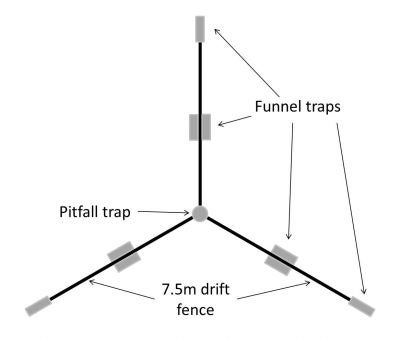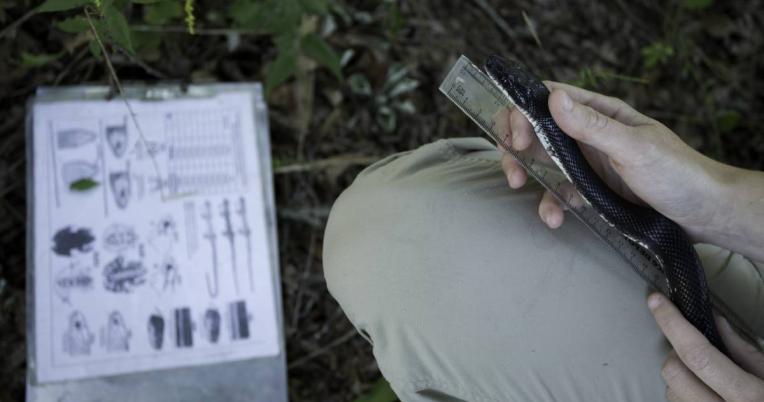Why we care
Amphibian and reptiles, also known as herpetofauna, are major components of our forest ecosystem due to their immense biomass! In fact, salamanders often have the greatest biomass of any vertebrate group in forested systems even though they are rarely observed. Herpetofauna are also an important trophic link, serving as both predator and prey. Due to their habitat needs and limited dispersal capabilities herpetofauna can be susceptible to changes in the forest environment making them a critical taxon to study on MOFEP. Additionally, although amphibians and reptiles are both considered herpetofauna, they are quite different when it comes to physiology and therefore will likely respond differently to forest management.
Many herpetofauna studies have researched the immediate and localized impacts following a disturbance, such as forest management, but less is known about how herpetofauna respond to management over the long-term and at a broader scale, which is exactly what MOFEP aims to learn.
Objective
Evaluate the impacts of forest management on abundance and species composition of amphibian and reptile populations.
Project design
- Total of 108 sampling arrays across the nine MOFEP sites
- 12 arrays per site
Each array has three drift fences leading to a centralized pitfall trap. Each fence is nearly 25 ft (7.5 m) long and is angled 120 degrees from the other fences. Each fence has three funnel traps, one on each side and one on the end opposite of the pitfall trap. This gives us a total of 10 traps per array.

- Why this design? - Drift fences are often used to study herpetofauna, and they help increase capture rates. Drift fences are made of a solid material that most herpetofauna species will not climb over, go through, or burrow under. Their purpose is to help direct individuals into one of the funnel traps or the pitfall trap. This method increases how many individuals we capture because we do not use any form of bait or attractant. It also does not rely on observer experience to find individuals, so it is a form of passive sampling. Passive sampling decreases observer bias, which is very important for a long-term research project!
- Sampling arrays were randomly placed using a split-plot design based on aspect (i.e., which direction the slope is oriented). The split-plot design helps us account for variation that we otherwise can’t control.
- Six arrays were placed on South- and West-facing aspects. These aspects generally have greater sun-exposure and have drier conditions.
- Six arrays were placed on North- and East-facing aspects. These aspects generally have less sun-exposure and therefore retain more moisture.
- Sampling occurs throughout the spring and fall for three years pre- and post-harvest
- Researchers check the traps at sampling arrays daily and record information on each individual captured. Individuals are then released unharmed.
What we have learned so far
- No herpetofauna species have severely declined or been lost due to forest management.
- Minimal evidence that forest management impacted species diversity at the site level.
- Only a few species exhibited site-level effects in response to even-aged or uneven-aged forest management.
- Environmental factors lead to natural population fluctuations in some species, supporting the need for a long-term dataset.
- Lizards and most snakes were more commonly captured on South- and West-facing slopes compared to salamanders and some frogs, which had higher captures on North- and East-facing slopes.
- Numerous amphibian and reptile species respond locally (i.e., stand-level) to harvest.
- Some species benefitted from disturbance and a more open canopy following harvest, others benefitted from undisturbed areas.
- The mosaic of habitats created by forest management may increase herpetofauna diversity across the landscape.
- We have documented multiple management-related habitat relationships that can be used to guide future forest management.
- Although our research shows no current need to change MDC’s forest management due to amphibian and reptile populations, as more area within the even-aged and uneven-aged sites receive management treatments we may see cumulative effects that impact the community. With continued monitoring we can provide the data necessary to guide management throughout the duration of MOFEP.
Management recommendations
- Minimize soil disturbance and compaction because many species spend their time below the surface or within the leaf litter.
- Consider aspect when applying management, what herpetofauna species are you most likely to impact?
- Leave down and dead wood and snags to provide shelter in disturbed areas.
- Clearcut areas should remain small and scattered across the landscape.
- Maintain or exceed Best Management Practices (BMPs) around ponds and streams where many amphibians breed.
- Balance needs of amphibians, which often need mature forest, with reptiles, which often respond well to canopy openings.
- Consider availability of surrounding habitat. If disturbance occurs, is their potential for species immigration or emigration?
- Carefully consider management options in areas with species of conservation concern.
- Never intentionally kill snakes. Give venomous snakes their space to reduce chance of envenomation.
MOFEP Herp Publications (PDF, 147 KB)
List of publications resulting from the MOFEP Herp project
Published on Aug 05, 2021 -
